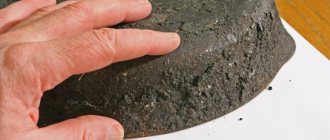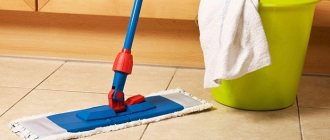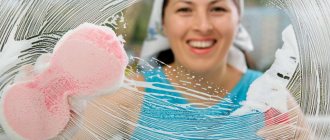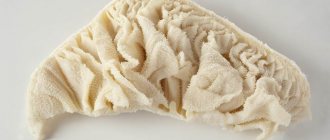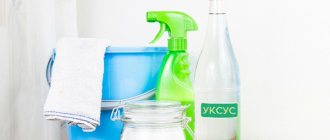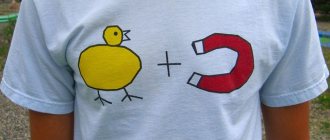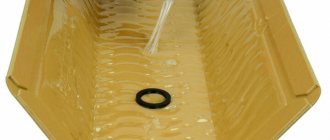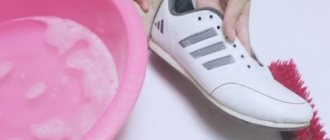Tile in the bathroom is a hygienic and beautiful design.
But during operation, plaque and streaks form on the tiles, and the grout in the joints darkens. Keeping tiles clean requires the use of available and special tools. In this case, it is necessary to take into account the intensity of contamination and the type of tile itself.
We will tell you in this article how and with what to clean tiles in the bathroom.
Cleaning methods
Each housewife sets her own cleaning schedule. The bathroom is one of the most frequently visited rooms in the apartment, and if you do not distribute cleaning procedures to daily, weekly and monthly, this will complicate the general cleaning of the bathroom, which will be carried out from time to time.
In addition, due to daily water procedures, humid air accumulates in the bathroom, which promotes the proliferation of bacteria, microbes and fungi on all surfaces.
Are you interested in effective methods for cleaning tiles?
Not really
spring-cleaning
If you wipe the walls and plumbing fixtures dry every day after using the sink and shower, then classic general cleaning in the bathroom can be done once a month. You will have to wash the tiles from floor to ceiling, and therefore you need to free up the work space as much as possible.
It is necessary to remove and soak the curtain in a soapy solution, put all the bottles with gels and shampoos, washcloths, brushes and other small items in a separate container, and put the rug in the wash.
Before cleaning the tiles in the bathroom, you should apply detergent compositions to particularly dirty areas and leave for 20-30 minutes to act. Only after this can you begin global cleaning of the bathroom walls, treating tiled areas and other bathroom surfaces with household chemicals.
Quick cleaning
You can quickly wash the tiles in the bathroom after taking a shower. Under the influence of steam, which is formed during the hygienic procedure, dirt and plaque on the tiles become wet, and they can easily be removed with any gentle detergent or even just a soft cloth or sponge. All surfaces should then be wiped dry.
If the surfaces do not become shiny after such quick cleaning, it means that plaque has formed on the ceramic tiles. To get rid of it, you will need special professional or home cleaning products for tiles.
The use of chlorine-containing compounds is allowed. With their help, limescale deposits caused by excessively hard water and rust are quickly removed. In addition, compositions with chlorine are suitable not only for cleaning tiles, but also for antibacterial treatment of surfaces in the bathroom.
No. 4. Lemon acid
Modern detergents are, of course, effective, but they also have disadvantages .
- Firstly, household chemicals can cause allergies .
- Secondly, it requires very careful handling, since sometimes the concentrations of aggressive chemicals in them can damage the skin of the hands and even the respiratory tract.
- Thirdly, some products cannot be washed off even with a large amount of water.
Therefore, it is not surprising that today many people abandon store-bought products and switch to using folk remedies.
The most popular and easiest way to clean ceramic tiles from grease , lime deposits and plaque is to use lemon juice . Problem areas should be thoroughly rubbed with lemon and left for a few minutes . Lemon juice can be squeezed out, diluted a little with water and sprayed with a spray bottle . After a few minutes, the juice is washed off with water . The bonus of this method is that the room will be filled with a pleasant and, most importantly, natural aroma.
An alternative is citric acid powder . The bag is dissolved in a glass of warm water and the resulting liquid is used for processing.
What can and cannot be used?
The tiles used to decorate walls can be different, but they are always durable and resistant to various types of influences. Many people mistakenly believe that such surfaces will withstand any chemical and mechanical means. However, even the choice of compositions intended for cleaning tiles should be considered carefully.
Most often, people choose finishing materials with a glossy surface. For such a coating, the use of abrasive substances and metal or hard brushes will be detrimental.
These products can quickly clean the tiles in the bathroom, but the small scratches they leave will eventually deprive the tiles of their original shine.
When choosing products for cleaning tiles, you must take into account that the joints between the tiles also require care, but the methods and means of cleaning them must be different. Exposure to acid-containing products will be destructive for building materials used as grout.
It is not recommended to use compositions intended for kitchen or plumbing equipment to clean bathroom tiles from limescale. You should also avoid products containing sand, pumice and fatty components.
After treatment with special cleaning emulsions, the matte tile surface should be coated with wax mastic, which will protect the porous surface from absorbing dirt and also highlight the structure and color of the material.
Careful care of tiles involves using:
- soft sponges;
- wool or felt napkins;
- toothbrushes;
- gentle detergents.
No. 12. Melamine sponge
A melamine sponge allows you to do without special cleaning agents ; more precisely, it is a detergent. Such sponges are made from melamine foam, which is capable of penetrating any hard surface and removing all kinds of dirt , stains and deposits. To clean, you only need to wet the sponge with plain water, using minimal effort. The melamine sponge can be used to clean a wide range of surfaces, incl. tiles.
Features of washing different types of tiles
Glossy tiles
Limescale deposits, soap stains and fingerprints are very noticeable on glossy tiles. You can remove dirt and return the tiles to their original shine using window cleaning liquid or a special detergent. To prevent plaque, the glossy surface can be coated with a water-repellent impregnation. It is advisable to apply such a solution as soon as possible after laying the tiles - the effectiveness of the product will be higher if the coating has not yet had time to absorb moisture.
Matte tile
The matte surface often leaves stains after washing and traces of dried water. This makes the tile look untidy. Matte tiles will look spotlessly clean if you apply one of the following recommendations:
- after washing, wipe the surface dry with a moisture-absorbing microfiber or bamboo cloth;
- add vinegar to the washing water (⅓ glass of vinegar per 5 liters of water);
- wash the floor with a solution of soda ash (3 tablespoons per 5 liters of water);
- after washing, rub the tiles with glycerin or a special tile polish;
- use a steam cleaner.
Relief tiles
Three-dimensional designs and patterns make washing relief tiles labor-intensive, especially in the case of old stains. Therefore, such tiles require careful and regular maintenance.
Foams and emulsions are best suited for cleaning structural tiles from dirt and stubborn deposits: such products penetrate well into pores and other irregularities.
To remove stubborn plaque and stubborn dirt, brushes with soft but thick bristles are preferred.
On glossy structural tiles, it is advisable to use polishes or detergents with the effect of a protective film.
Floor tiles
Floor tiles are most often made matte, since this particular coating does not become slippery even when water gets on it. Therefore, for washing floor tiles in the bathroom, the same techniques are relevant as for matte wall tiles. But in addition, you should take into account that floor tiles become more dirty than wall tiles.
To maintain cleanliness, the tiled floor in the bathroom should be swept and wiped daily with a clean mop soaked in a vinegar solution. Otherwise, soap splashes, toothpaste, water and cosmetics that fall on the floor will form stains that will attract dust and small debris. Once dry, it will be more difficult to remove such stains.
A special polish will help reduce the maintenance of floor tiles as much as possible.
What does the type of cladding affect?
For tiling surfaces in the bathroom, tiles with different characteristics can be selected. All its features must be taken into account during the cleaning process .
Matte coating
On a matte surface, traces of water and soap splashes appear after drying in the form of a whitish coating. Due to the specific nature of the tiles, it is advisable to use solutions with good penetrating ability. For example, vinegar solution for wall tiles and soda solution for floor coverings.
After cleaning, the matte wall covering can be rubbed with glycerin. It is not recommended to do this with floor tiles as they will become slippery.
Embossed
It is more difficult to keep textured tiles clean than matte and glossy ones. An uneven surface with depressions and protrusions allows dirt to accumulate on such a coating.
To deal with dark stains in recesses, you will need a brush and cleaning products that provide good penetration .
Gloss
Glossy tiles should not be washed with abrasive products. The best choice is liquid and gel non-aggressive preparations, which are applied and distributed with a sponge or rag.
Mirror and glass cleaner is also . This approach will give the tiles a streak-free shine.
To maintain the cleanliness and shine of a smooth surface, a moisture-repellent agent can be applied on top of it.
Floor tiles
Cleaning floor tiles is carried out similarly to wall tiles. The same store-bought products and homemade formulations will do .
The regularity of floor cleaning depends on the intensity of use; it should be carried out regularly. Most often, tiles with a matte surface are chosen as flooring.
Cleaning Rules
There are several rules for cleaning bathroom tiles from plaque at home. Compliance with them will allow you to achieve a result comparable to what happens after the work of cleaning company specialists using professional bath cleaning products and methods and a steam cleaner for tiles.
To save time and effort during cleaning, you can use the following recommendations:
- Before you start washing the walls, you need to open the hot water tap in the bathroom for a few minutes and close the door tightly. After this steam treatment, the surfaces will be easier to clean.
- You should start cleaning bathroom tiles by washing them with warm soapy water. You can use dishwashing detergent, but not soap, which leaves a difficult-to-remove film on the surface.
- Movements when applying detergent are made from bottom to top, when wiping the tiles dry - from top to bottom.
- If there is severe contamination on the walls, then you can resort to the use of special potent compounds. They should not be applied to large areas at once, because... Dried product is more difficult to wash out.
- We must not forget about health. Rubber gloves and an apron will help protect your skin from aggressive compounds, and a construction respirator will help protect your respiratory system from harmful fumes.
Specialized household chemicals
Many products only remove fresh dirt well. It is difficult to remove old limescale or rust with them.
Silit Bang dissolves fats and breaks down lime deposits.
At home, it is convenient to use strong but not too aggressive drugs:
- "Silit Bang". Breaks down fats, dissolves lime deposits, and can remove yellow rust stains. The composition is non-aggressive towards all materials used for cladding: it can be used to clean acrylic and various types of plastic, porcelain stoneware, tiles with various surfaces, glass.
- "Mister Muscle". Dissolves soap and lime stains, is easily washed off with water and leaves no marks on different types of wall coverings.
- "Comet". The products are available in the form of sprays and gels with cleaning properties. If you need to quickly wipe clean surfaces to maintain shine, use a spray, but it is more convenient to treat difficult stains with gels.
- Kiilto Clean for tiles. The product contains oxalic acid and is harmless to glossy glazed ceramic surfaces, but can damage gypsum grout.
- "Domestos". Thick gels and sprays have a bactericidal effect. The bathroom will not only be clean, but also safe for health. When mold appears, the tile joints are treated with thick gel.
Domestes rids tiles of mold.
How often to wash?
You need to keep your bathroom clean every day, and not just on those days when you do a general cleaning of the house. To do this, it is enough to spend no more than 10-15 minutes in the bathroom.
After taking a bath or shower, rinse surfaces with clean water and wipe dry to get rid of stains. For regular maintenance of tiled walls, a glass and mirror cleaner is suitable.
Every week you need to pay attention to the seams between the tiles, because... they create a suitable environment for the active proliferation of bacteria. You need to carefully wipe the tile seam from plaque and dirt. You can use bleach and soda for this.
Every month you need to do a thorough cleaning of the bathroom, using as many products as possible. And not only those that can quickly wash bathroom tiles.
Even with daily wiping of surfaces in the bathroom, general cleaning requires a little more diligence. Therefore, you will need deodorizing products to remove odors, disinfectants, and those that can help get rid of old mold in hard-to-reach places that have not previously received enough attention.
No. 7. Vinegar
Acetic acid , like citric acid, can destroy fatty deposits, plaque and other contaminants. It is better to use regular table vinegar with an acetic acid concentration of no more than 6%. If you only have vinegar essence with a concentration of 80% , then it is better to dilute it with water in a ratio of 1:11.
to apply the vinegar solution to the tiles using a spray bottle . If there is serious dirt on the surface, it is better to leave the product for 20-30 minutes so that it breaks down the plaque. The surface with vinegar applied to it can be additionally cleaned a soft brush of a neutral color. After the manipulations, all that remains is to rinse the surface with warm water and wipe it with a soft microfiber cloth.
A big advantage of the method is the harmful effect of vinegar on mold , but when working with acid it will be necessary to protect your hands and respiratory organs . This method is not suitable for those who are hypersensitive to odors. Frequently washing tiles with vinegar can lead to destruction the joints between the tiles , so it is better to alternate this method with others.
Remove plaque
Daily contact with water leads to the formation of limescale on the surfaces of the bathtub, sink, taps and walls. The water evaporates, and a particle of lime remains in place of the drop.
On the walls, drops of water mix with foamy splashes of soap, shampoo or shower gel. Both soap and limescale deposits should be washed off immediately, because stains that are initially invisible will eventually turn into a thick layer, which will be much more difficult to remove.
To clean limescale from tiles, you can use a special gel, emulsion and factory-made powder, or use improvised means (citric acid, baking soda, etc.).
During cleaning, it should be taken into account that it is impossible to clean the tiles in the bathroom from plaque using folk remedies or store-bought ones in one go. The procedure will have to be repeated several times. And this fact only confirms the importance of preventative daily cleaning.
Rules for working with cleaning products
Most grease removers - both homemade and store-bought - can cause an allergic reaction, poisoning, or, if actively inhaled, a lung burn.
To work with household and folk chemicals, you must strictly follow the safety rules:
- Cover your clothes with a long, thick apron;
- be sure to wear rubber gloves;
- do not lower your head low to the surface to be cleaned so that the acid vapors do not burn your throat and lungs;
- read the instructions for the purchased product;
- remove all food products from the table and kitchen counter;
- Make sure that children and pets do not have access to the kitchen.
After cleaning, wash your hands, face and neck very thoroughly, it is even better to take a shower with shampoo and soap. Rinse the gloves thoroughly, wash the apron in the machine. After cleaning the kitchen, it is better to immediately throw all clothes into the washing machine.
Before work, it also makes sense to make sure that the window in the kitchen is open, and if possible, you should also turn on the hood. You should not inhale fumes from household chemicals or vinegar - they can cause a real burn to the larynx and mucous membranes.
After washing the tiles, the window should be left open for at least 30 minutes in winter, and for two hours in summer, so that all the toxic fumes are blown outside.
Remove mold
The warm and humid atmosphere of a plumbing room often causes mold to form. Mold must be removed immediately before the spores spread throughout the room. In the bathroom, mold can damage not only the tile seams, but also untiled walls, curtains, pipes, and plastic surfaces.
Mold eats deeply, damages furniture, and gives off an unpleasant odor. In addition, a room contaminated with mold poses a danger to human health.
Chlorine-containing products, copper sulfate, and vinegar will help get rid of black mold stains. Aqueous solutions prepared with these substances should be applied to the surface using a rag or spray bottle and left to act until completely dry. After a few hours, the applied products can be washed off with water and the room dried.
The treatment will have to be carried out several times with a break of 1-2 days. If mold has infected the tile joints, the grout will have to be scraped out and new grout applied after treatment with an antibacterial compound. Each treatment should be carried out in a well-dried and ventilated area.
Video description
How to clean the grout between tiles quickly? Top 10 ways to clean tile joints.
Chalk
It is recommended to treat floor coverings made of glossy tiles with ordinary chalk. Procedure:
- Mix chalk and water to form a mushy consistency.
- Apply the prepared mixture to the surface of the tile.
- Remove the resulting layer along with the dirt.
Advice! To make the tiled floor shine, it additionally needs to be wiped with paper.
Chlorine
For those who can tolerate the unpleasant chlorine smell, it is recommended to try the following recipe:
- Dilute a tablespoon of chlorine in 1 liter of water.
- Treat the tiles with the prepared liquid. In this case, it is advisable to use a sprayer.
- Wait about ten minutes.
- Wipe the surface with a clean cloth.
As practice shows, a chlorine solution can easily cope with even stubborn stains. It is extremely important to use rubber gloves when cleaning.
All chlorine-containing compounds are toxic; if they come into contact with the skin or mucous membranes, the affected area should be rinsed thoroughly with running water. Source sib.fm
Cleaning products
To care for a tiled surface, the easiest way is to use ready-made special products that are sold in household chemical stores. They are ready for use and do not need to be diluted or mixed with other substances. However, there are no universal ones among them, so before purchasing you should carefully study their purpose.
A good product must meet the following requirements:
- Be gel-like or liquid. It is better to avoid the use of powders and abrasive pastes, because they spoil the glaze layer, and over time the tile will lose its shine, the gloss layer will be erased irrevocably.
- It is desirable that it contains chlorine. This component makes the product almost universal, because... not only helps to cope with various contaminants, but also destroys bacteria and unpleasant odors.
- Does not contain chalk. Many housewives have long abandoned the use of chalk to clean tiles, because to wipe off the white coating on the tiles will require additional time and effort.
- Does not contain acids. Their impact destroys the layer of putty and grout in the seams.
No. 9. Hydrogen peroxide solution
This remedy is called universal and very effective. It will help cope with any kind of pollution , and all components can be found in almost any home. The paste is prepared from ½ cup of baking soda, ¼ cup of hydrogen peroxide and 1 tsp. liquid soap . All components are thoroughly mixed. If the contamination is minor, the paste can be applied to a sponge and wipe the desired area, then rinse the surface with water. If the contamination is severe, then the paste can be left for 10 minutes : the dirt will begin to dissolve under the influence of the components of the mixture and in the end it will be much easier to wash off.
Professional products
When choosing in the store how to clean the tiles in the bathroom from plaque, it is recommended to pay attention to the following household chemical products:
- MULTI FRESH . Produced by the Belgian company Cid Lines. It has a chemically balanced composition that removes most contaminants without streaks.
- CILLIT BANG Universal (purple bottle). Manufacturer: RECKITT BENCKISER. Removes limescale, rust, soap stains and other stubborn stains from various surfaces.
- CILLIT . The white bottle indicates that the product is designed specifically for cleaning surfaces from plaque and rust.
- SANI CLEAN SUPER . Designed for removing lime deposits from acid-resistant surfaces. Before cleaning the tiles in the bathroom, you need to dilute it according to the instructions.
- Sanitol . Manufacturer: GREENFIELD. Removes salt deposits on tiled bathroom walls, instantly dissolves soap stains, and adds shine to the surface.
- Gel SANITA . Russian product produced by the Stupino Chemical Plant. The bottle has an additional mark “Anti-rust”, but the gel effectively removes limescale and gives the surface shine.
- CHISTIN gel . Another domestic product. Positioned as a sanitary and hygienic product that is used for washing any plumbing equipment, tiles, earthenware.
- Kenolux S100 . The Belgian product contains lactic acid, which can remove any dirt from the surface of the walls. The product is considered safe for seams and putty.
- HELP . Gel-like product for tiles and plumbing. Suitable for full-scale cleaning of plumbing units - cleaning walls, toilets, sinks, taps. Effectively removes water stone and rust. Gives surfaces shine.
- Mr. Proper . The liquid product is considered universal and does an excellent job of removing any old stains on tiles. Does not leave streaks and fills the room with a pleasant aroma.
Household chemicals have a number of advantages. They do an excellent job of destroying bacteria, unpleasant odors, and mineral deposits, but their cost makes us remember that traditional methods also cope with washing tiles just as well.
Top 3 special compositions for washing
The range of household chemicals includes a wide range of special products for cleaning the bathroom, and tiles in particular. Such preparations allow you to thoroughly clean the surface, eliminating even stubborn stains.
Cillit Bang “Anti-raid”
An acid-containing cleaning product effectively removes:
- rust,
- soap stains,
- lime.
The product is applied to the stained surface by spraying or sponge. After 5 minutes, it is removed and the tile itself is washed with plenty of water.
The average price is 270 rubles.
Unicum spray
The product allows you to remove limescale deposits from tiles and properly process seams . Unicum is antibacterial and removes odors well.
Contains chlorine and surfactants. Treatment with a spray is simple, the drug is well distributed. Manufacturer – Israel.
Price – about 250 rubles per bottle.
Mellerud
Concentrated detergent is available in liquid form. Cleans Mellerud carefully and effectively without harming surfaces .
The product is suitable for ceramics and natural stone that does not contain limestone, since the composition contains acids. Effectively removes rust and lime. Manufacturer – Germany.
The liquid is applied to the moistened surface either diluted (1:5) or pure. For best results, the product must be rubbed with a brush. Wash off with plenty of water.
The average price is about 550 rubles.
Folk remedies
You can make your own equally effective tile cleaning products. The components of folk remedies do not act as aggressively on the treated surface as chemical industry products, so removing stains will take longer.
But such compositions do not contain substances hazardous to health and the environment, which allows them to be considered a good alternative to household chemicals for people who suffer from allergies or have small children.
The preparation of any composition requires compliance with proportions. It is more convenient to apply them using a spray bottle.
During work, it is recommended to use gloves and a respirator to avoid skin burns and respiratory tract irritation.
Vinegar
The most common cleaning product among housewives, which can be used for both daily and general cleaning.
Vinegar removes any dirt, incl. calcium deposits and rust, disinfects surfaces. 1 part of the essence is diluted with 10 parts of water, applied to the walls using a spray bottle and left for several minutes. Then rinse off with clean water and wipe the tiles dry with a microfiber cloth.
Table vinegar 6%, diluted in equal proportions with water, can be used daily to prevent the formation of mold fungi.
Soap
Soap is the worst enemy of glossy ceramic tiles. It forms a thin film of fat on the tile, which is not so easy to remove. The fatty base of soap can provoke the appearance of mold fungi, which will be difficult to get rid of.
Instead of soap, it is better to use dishwashing detergent, which perfectly removes grease and dirt. And then apply a composition designed to combat rust, mold or other contaminants.
Soda
Baking soda will help get rid of limescale. It should be used carefully, without using force when applying, because... solid particles may scratch the tile surface. You can soften the powder by bringing it to a paste using a liquid component.
To remove dirt and mold from the seams, use a toothbrush to rub in a paste of baking soda and water. After treatment, just rinse off the applied composition with clean water and wipe the surface dry until shiny.
You can dilute soda powder not only with water, but also with bleach or any bleach.
Another way to use: after applying the soda slurry with a brush, sprinkle with vinegar.
Lemon acid
You can restore the shine to dull tiles and eliminate mold spots using citric acid. Using a damp sponge, rub the dry powder into the contaminated areas, and after 3-5 minutes, wash off with clean water.
An alternative is to wipe the seams and dirty areas with fresh lemon juice (half a fruit).
Ammonia
Pharmacy 10% ammonia solution is ammonia. The product has a characteristic pungent odor, so when working with it you should definitely use a respirator to protect your respiratory tract.
If you dilute 1 tbsp. l. ammonia 1 liter of water, then you can get a universal household cleaner. Experienced housewives use this solution to wash mirrors, windows, and crystal. Ammonia will help and restore the original appearance of the tiles.
You can strengthen the aqueous solution of alcohol with vinegar by adding 1 tbsp. l. The mixture should be sprayed over the surface with a spray bottle, and after 5 minutes, rinse with water. Polish clean tiles with a soft cloth.
A mixture of alcohol and hydrogen peroxide (2:1) can remove traces of rust.
Chlorine
It has a pungent and persistent odor and is irritating to the respiratory system and eyes. But at the same time it is considered the best means for cleaning white tiles and disinfecting the room. Before cleaning mold from colored tiles and grout, the effect of even a weakly concentrated bleach solution should be tested in a place hidden from view.
Dentifrice
All smooth and shiny surfaces can be wiped with a mixture of 2 tbsp. tooth powder and 1 tsp. ammonia.
Borax
Used as a component of many detergents. Effective in deodorizing and disinfecting premises. To clean tiles, borax powder is applied to contaminated areas and tile seams using a damp sponge.
Melamine sponge
The melamine sponge appeared in the arsenal of housewives only a few years ago. The sponge is universal; it can be used to clean different surfaces and stains without using detergents. A dry or moistened sponge works equally effectively, but it should not be soaked in hot water or wrung out with twisting movements.
No. 2. Dishwashing liquid or soap
Light stains can be washed with ordinary dishwashing detergent . It is enough to dissolve a small amount of it in warm water until foam forms. The resulting solution is applied with a sponge to the contaminated tiles, left for 10-20 minutes , and then thoroughly washed off with plain water.
Instead of detergent, you can use regular toilet soap ( using laundry soap is not recommended ). To make the dissolution process faster, you can rub the bar soap into warm water. Next, the washing process is similar to that when using dishwashing detergent.
How to clean the tiles after completing the renovation?
It is almost impossible to protect walls and floors from splashes, drops, drips, and stains during finishing work. However, you can prepare for subsequent cleaning of the tiles. Moreover, this is not difficult to do, since the building material used during the work is known. For decorative finishing of the bathroom with tiles, use:
- adhesive solution;
- grout;
- primer;
- plaster;
- silicone sealant.
In addition, the tiles may have stains of lime, paint, foam, or traces of construction dust. The simplest algorithm of actions before washing the tiles involves:
- cleaning the walls with a vacuum cleaner from dust and adhering particles of building materials;
- scraping off frozen particles of hard building materials with a small blade or soft spatula;
- washing smeared construction mixtures with special solvents;
- wet treatment of walls with detergents;
- polishing tiles.
Removal products for most construction compounds can be purchased at specialty stores.
Adhesive solution and silicone sealant
Even with the most careful finishing work, excess adhesive will appear in the seams. They must be removed immediately with just a damp cloth and a spatula. If the mixture is dry, then:
- You can wipe off the tile adhesive after it has soaked under a damp cloth. To remove polymer glue, the fabric is moistened with a solution of acetone, ammonia, and vinegar. A solvent will help remove epoxy adhesive stains.
- You can try to remove dirt mechanically. To do this, use sandpaper, a stiff brush, or a scraper. You must act extremely carefully so as not to spoil the glaze layer.
- Porous ceramics will be more difficult to clean because... the compositions eat deeply into the structure of the finishing material. In order to select the right solvent, you should know what kind of glue was used. On the packaging of building materials, manufacturers indicate a solvent suitable for cleaning.
Silicone sealant, used to seal joints (for example, between a bathtub and a wall), protects against moisture and prevents the development of fungus and mold. To ensure accurate application of the sealant, it is recommended to protect the surfaces with masking tape.
This building material firmly adheres to any surface, and it is extremely difficult to remove dried sealant. It will have to be cleaned mechanically (scraper, blade) or chemically (white spirit). Both methods are dangerous for adjacent surfaces; the result can be scratches, chips, areas corroded by chemicals with disruption of structure, color and loss of shine.
Removing primer and cement
These construction mixtures are also easier to clean up right away. This requires no effort, just a wet cloth. If dried stains are found on the tiles after completion of construction work, then the first thing you need to do is try to soften them. Moreover, you can try to moisten the primer stains with fresh primer and then scrape them off with a scraper. For cement, a rag and scraper moistened with hot water will do.
Grout
Most often, the tiles in the bathroom after renovation have to be cleaned of grout. The use of grout mixture is the final stage of finishing work. Experienced craftsmen seal the joints and remove excess mixture at the same time, while trying not to smear the composition on the tiles, and carefully wipe it with a dry and damp sponge.
Dried grout stains are washed off more easily than an adhesive solution, but the procedure will have to be repeated several times. After the top layer has dried (the seams become lighter), the wall should be moistened with clean water and then rinsed off with another clean sponge.
If epoxy grout was used, then you cannot do without a special solvent.
Divorces are different
What does this unpresentable cloudy “rainbow” leave on the tile? There are usually four types of tile contamination:
- Household dirt.
- Limescale.
- Fat.
- Detergent residue.
They ideally remove all of the listed substances that contain acid - it both destroys the structure of the dirt and gives the much-desired shine.
Do not forget about the timely removal of fresh contaminants
Cleaning joints between tiles
The tile seams are the most vulnerable spot on a tiled wall. They quickly lose color because... Dirt most often accumulates in them and mold develops. They are also unstable to some cleaning agents. For example, under the influence of hard tools and acidic detergents, the grout mixture may collapse.
The following are considered safe for cleaning seams:
- Steam cleaner. A powerful jet of steam will not only clean any type of dirt, but also get rid of fungal infections. No additional chemicals are required.
- Toothbrush. It is convenient and safe to apply cleaning compounds.
- Gel and liquid bleaches and antiseptics.
If the seams cannot be cleaned or the area of clearance is large, then the easiest way is to replace the grout. To do this, you need to arm yourself with a thin, sharp tool (such as a scraper) to clean out the damaged grout, a new mixture (preferably epoxy) and a rubber spatula. During work, the seams must be soaked with an antiseptic.
Bleaching the seams
Seams that have darkened but remain intact and not affected by mold can be bleached. For work, use household chemicals or improvised products. The most common of them:
- Marker. It is simple to use, but the effect of such an update is short-lived.
- Ready-to-use composition with a whitening component - German Mellerud, Canadian Grout. Both products are designed for cleaning grout, have properties that restore the color of grout, and remove mold and stains.
- A mixture of hydrogen peroxide and baking soda. A paste of these ingredients is rubbed into the seams with a toothbrush and left for 1-2 hours. Then the seams are thoroughly wiped.
How to clean tile grout?
When tiling a bathroom, the seams between the tiles are the most demanding areas to care for . They have a more porous surface compared to tiles, and it is in the seams that mold most often forms and dirt accumulates.
To handle the joints of tile slabs, it is convenient to use brushes with small bristles. For example, old teeth.
Chlorine-containing preparations
One of the products with chlorine, for example Domestos or Belizna, can help clean white seams . This treatment also serves as a means of preventing mold. But it cannot be used on colored grout.
Steam cleaner
If possible, the seams between the tiles, as well as the tile itself, can be treated with a steam cleaner. This method is hygienic and does not require the use of additional cleaning products.
Hydrogen peroxide
To bleach white grout, use the following mixture:
- hydrogen peroxide – ¼ tbsp.;
- water – ½ cup;
- liquid soap – 1 tbsp. l.
All ingredients are mixed. This product can be stored. But if a brush has already been dipped into it during cleaning, the solution is used for only one procedure, and the residue is poured out.
Whitening markers
A special whitening marker will help to refresh the grout while simultaneously treating the joints from mold. If the mold damage is serious and deep, then it must be completely removed and replaced with a new one containing components that protect against fungus and mold.
When starting to clean grout, you need to take into account that strong compounds can damage the grout.
The video will tell you how and with what to clean tile joints:
Tile care
There are no housewives who don’t want everything in the bathroom to sparkle, look fresh and comfortable. Moreover, it is not at all necessary to resort to the help of professionals from the cleaning service to restore cleanliness. Achieving sparkling cleanliness in your bathroom and sprucing it up yourself is not so difficult using modern methods and cleaning products.
The main thing is not to wait for the tiles to start attracting attention because they are faded or ready to fall off!
Correcting minor imperfections in a timely manner and maintaining a clear wall cleaning schedule will prevent major problems and keep your bathroom shiny and safe.
How to prevent problems from occurring?
To prevent the destruction of the decorative coating on the walls in the plumbing room, just listen to the advice of professionals:
- Immediately after renovation. Within a few days after installation, a whitish salt coating will appear on the surface of the cladding. This occurs due to the evaporation of moisture. The plaque must be washed off with an acid solution.
- Unglazed tiles should be periodically coated with liquid wax, glossy tiles with vinegar.
- It is also possible to avoid the occurrence of mold fungi. To ensure good ventilation in the room, there must be a ventilation gap of at least 2.5 cm between the door and the threshold.
- After each hygienic procedure, the walls should be wiped dry with a soft cloth. Terry or bamboo towels, microfiber, and suede are suitable for this purpose.
- You can use glass cleaner to make the tiles shine.
- You should familiarize yourself with the purpose and instructions for using the chemical in advance. You cannot use compositions on walls, for example, intended for cleaning toilets.
- The more concentrated the product, the less it should be kept on the surface being treated. When dealing with old plaque, it is better to repeat the procedure several times.
- You should use chlorine-containing cleaning products in the bathroom at least once a week.
But the most important advice: if you learn to pay attention to cleaning the bathroom every day, then general cleaning, which is necessary once a month, will not take more than 30 minutes.
In case of cracks and chips
While cleaning, housewives are sometimes annoyed to discover that a small chip or crack has appeared on the tiles. Also, often when you use a hard brush carelessly, the tiles in one place begin to crumble and crumble.
If it is not possible to replace the tiles in the near future, you can buy a special repair compound or carefully paint the damaged part.
But ideally, replace the damaged part with a whole one.
To prevent mold from settling in the crack while you wait for repairs, you can carefully mask it with grout or regularly wipe it with a mixture of soda and vinegar.
You can wash tiles with a crack using the same products as whole ones. You just need to reduce the amount of acid in the solution or dilute the concentrate in more water.
After cleaning, damaged tiles should be very carefully wiped dry with a towel or rag.
A chip on the surface can be temporarily covered with tile wax so as not to wash the base of the tile when cleaning.
Useful tips
The following expert recommendations will help you clean tiles effectively and without errors
- Do not clean with metal scrapers or brushes, as this may damage the surface.
- Cleaning the tiles should be done regularly, taking care not to let the condition worsen. Quick cleaning is wiping off splashes of water after taking a shower, maintenance cleaning is at least once a week, general cleaning is at least once a month.
- It is advisable to test strong household chemicals on an inconspicuous area before first use.
- A whitish coating on the tiles will form more slowly if you wipe the tiles dry with a napkin after each shower.
- If repair work is carried out when the tiles have already been laid, they must first be covered with a protective film.
- Properly organized ventilation in the bathroom will prevent the formation of condensation and mold.
- For better preservation, it is recommended to treat grout joints with moisture-resistant impregnation.
- Residues of cleaning product must always be removed from the tiles.
- To wash hard-to-reach areas (in corners, at joints of complex shapes), it is convenient to use an old toothbrush.
- A tile with a damaged surface loses its resistance to strong cleaning agents.
Chlorine-containing cleaning products can be used very limitedly - only on white tiles, and with good ventilation. In this case, it is necessary to use personal protective equipment.
General cleaning recommendations
You need to choose a cleaning agent to remove stains from tiles depending on the type of coating (tile, plastic, terracotta, etc.), as well as taking into account the type of dirt. Fresh stains of any origin can be easily wiped off with a soap and soda solution. Soda, as a soft abrasive, can even cope with rust or lime salts. But old stains will have to be removed with aggressive household chemicals.
Washing tiles with soap and soda solution.
To prevent damage to the wall covering during cleaning, you must follow the following rules for caring for it:
- when using acid-containing chemicals, protect tile joints;
- do not use hard metal sponges and brushes, do not scratch stains with a knife;
- It is better to choose thick gels;
- It will be possible to wash the tiles without streaks only by thoroughly rinsing the surface;
- After treatment, mirror glass tiles must be wiped with window cleaners until they shine.
Causes of pollution
You need to clean stains based on the cause of their occurrence. The most common:
- hard water. It leaves behind divorces;
- A cleanser that is not completely rinsed off. This is why many people make do with plain water;
- fat. First you need to remove the stain, and then wash the entire floor so as not to leave greasy marks all over the surface;
- dirty rag. You need to rinse it regularly and very thoroughly;
- dirty water. You need to change it regularly, otherwise, when the floors dry, dirty streaks will remain on them and you will have to completely wash everything.

